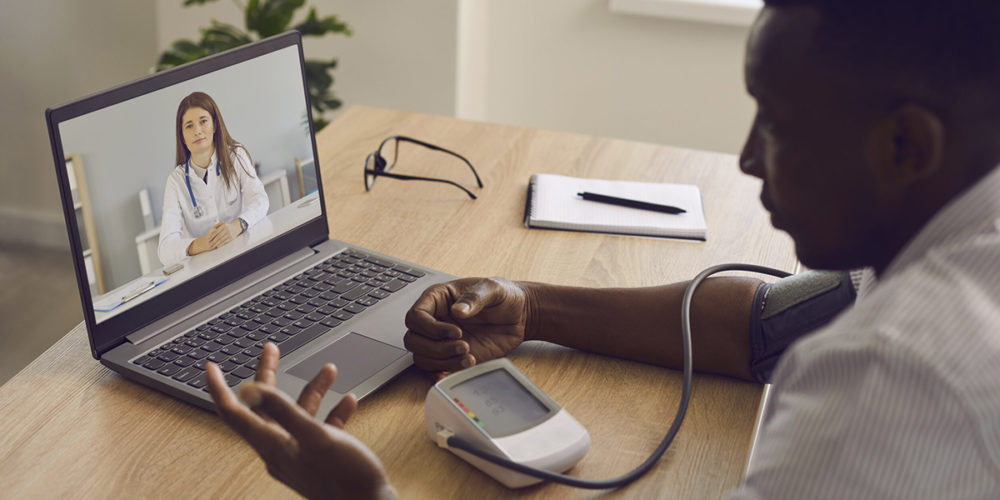Shahid Shafi, MD, MBA, MPH
Fig.1: Efficient collection, transmission, tracking and analysis of patients’ health data in real-time with our remote monitoring system.
Introduction
The healthcare industry is undergoing a significant transformation, driven by a growing focus on improving access to care at or close to patients’ homes. An emerging digital tool in this space is Remote Patient Monitoring (RPM). Using wifi or cellular enabled devices at home, patients transmit their data to a central monitoring system in real time. A plethora of devices are now available to meet the needs of the patients at home. The information from these devices is then shared with their healthcare providers in real time or asynchronously, depending upon pre-defined clinical criteria.
RPM is proving to be a cost-effective, convenient and efficient way to improve patient outcomes, reduce the cost of care, and prevent hospital admissions/readmissions. It also has the potential to transform healthcare from treating illnesses to promoting health and wellness, thus enhancing quality of care.
Patient Experience
With the spread of “consumerism” in healthcare, convenience and easy access to care has become an important differentiating factor for patients, when it comes to choosing their providers. RPM provides patients with the care and support they need in the comfort of their own homes. It is particularly useful for those with chronic conditions (e.g., diabetes, congestive heart failure, COPD), those transitioning from acute or post-acute care facilities to home, and those who may qualify for “hospital-at-home” care.
Another key advantage of RPM is increased patient satisfaction, through engaging and empowering patients in their own care. By having access to their own health information, patients can make informed decisions and take an active role in their care. This can help to improve compliance with treatment plans and lifestyle changes, which can improve patient outcomes.
Improved Outcomes
A primary benefit of RPM is early detection of changes in a patient’s condition thus preventing complications, ED visits, hospital admissions and readmissions. It allows healthcare providers to monitor patients more frequently and intervene early, before it deteriorates further. For example, if a patient’s blood pressure or blood glucose levels are elevated, healthcare providers can respond quickly, adjust treatment plans, and prevent potential complications.
Another key benefit of RPM is monitoring compliance with treatment at home. Devices, such as the smart pillbox, helps keep track of the medications at home, their dosage, and the frequency, ensuring that patients take the right amount of medication at the right time. It can generate alerts for the patients to take their medications, as well as increase accountability by providing a complete record of medicinal intake.
RPM can also use gamification techniques to make the monitoring process more engaging and fun. For example, patients can be rewarded for meeting certain health goals, such as taking their medication on time, or for reaching a certain number of steps each day. This can create a sense of accountability and motivation for patients to adhere to their treatment plan.
We talked with ACHE member, Melinda Schmidt, MBA, BSN, RN, about her experience with RPM, having spent many years in the industry. She offered this great example of how RPM can prevent the spread of illnesses and potentially improve outcomes, “When I worked as a triage nurse in a busy hospital emergency department in the winter of 2009, a mother came in with her week-old newborn boy who had a new rash on his arm. She was unaware that over 200 people were waiting to be examined for H1N1, RSV, and Influenza in the crowded waiting area. H1N1 of 2009 was our first pandemic in more than 40 years and was causing mayhem in the healthcare system as many ERs were overflowing with patients.
In addition to whatever else was lurking in our waiting area, the mother was exposing this baby to H1N1, RSV, and Influenza. I immediately triaged the newborn and moved them to our Fast Track area, where the doctor informed her that it is fairly typical for newborns to acquire a rash during their first week. The rash usually disappears within a few days and, if necessary, can be treated with a topical ointment.
If the mother had access to RPM, she could have contacted her pediatrician from the comfort of her home, and the medical professional would have identified the rash. The newborn would not have been exposed to any pathogens from the emergency room if RPM had been used. To this day, I wonder if the baby contracted anything from the ER visit.”
Financial Benefits for Healthcare Providers
RPM can reduce the costs to the hospitals associated with readmissions. By enabling patients to receive treatment at home, home health services can lower staffing costs. Office-based practitioners can reduce the burden of phone calls from patients on their staff and minimize disruptions in their schedules by using RPM to provide proactive care at home using predefined treatment algorithms.
RPM can also help medical practices, hospitals, and home health providers to improve their revenue streams:
- Reimbursement for RPM: On a per patient per month basis from Medicare and other payors, without the need for direct physician interaction.
- Increased patient satisfaction: By providing convenient and accessible services at home, RPM can lead to increased patient satisfaction and loyalty.
- Increased efficiency: RPM reduces the need for in-person visits for routine check-ins and monitoring, reducing the time and resources required for in-person visits and improving the efficiency of the practice.
- Increased revenue from new patient populations: RPM can make healthcare services more accessible to patients who have difficulty traveling, such as elderly patients or those living in rural areas.
- Improved coding and billing accuracy: RPM provides a wealth of data that can be used to support accurate coding and billing, potentially reducing the risk of denied claims and increasing revenue.
Implementation of RPM
The implementation of RPM requires careful planning and preparation. The first step is to identify the patients who are suitable for RPM. This may include patients with chronic conditions, those who have recently been discharged from the acute care or post-acute facilities, and others who require ongoing monitoring and treatment, including “hospital at home.”
Once the patient population has been identified, healthcare facilities need to choose the appropriate RPM technology. There are a variety of options available, including wearable devices, mobile applications, and remote monitoring systems, each with its own advantages and disadvantages.
The next step is to train healthcare providers, support staff, patients and their caregivers at home. This includes training on how to use the technology, how to interpret the data, and how to effectively communicate with patients.
Healthcare providers also need to establish clear clinical guidelines for RPM, including the frequency of monitoring, the types of data and information that will be collected, and the response time for addressing changes in a patient’s condition. These protocols and guidelines should be clearly communicated to patients, as well as their families and caregivers, to ensure their understanding and expectations.
In conclusion, RPM is an effective solution for improving patient outcomes, reducing cost of care, and an important new source of revenues for healthcare providers.
source: https://achentx.org/newsletters/spring-2023/

